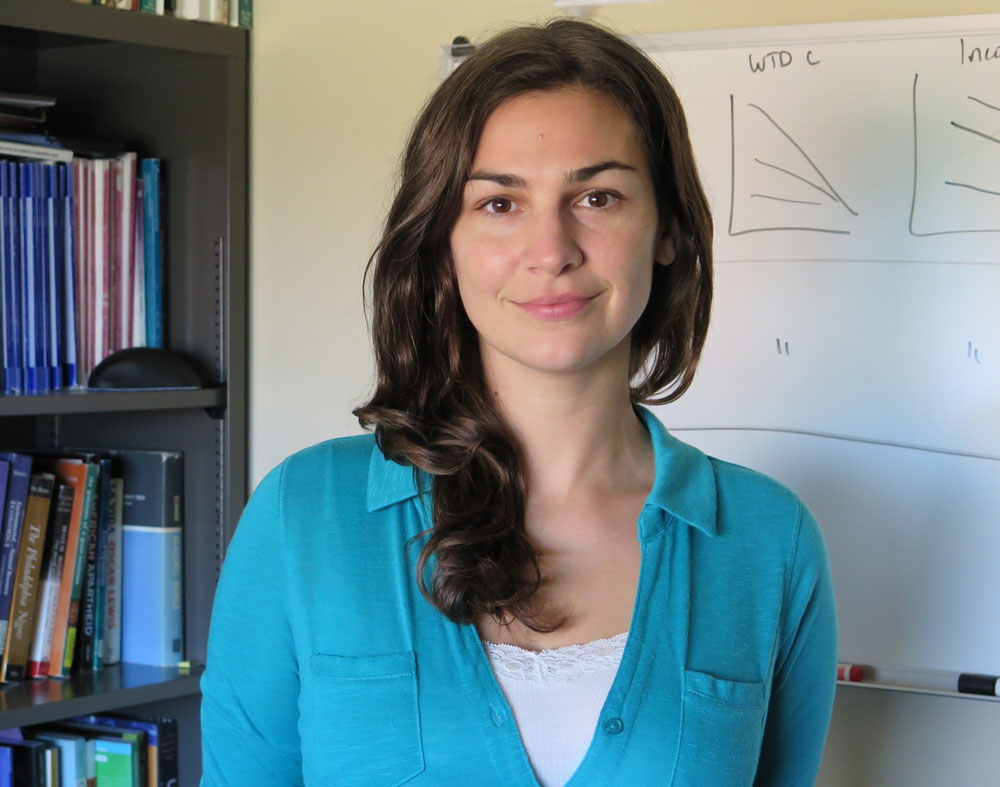In January, President Joe Biden established a White House Environmental Justice Interagency Council to address current and historic environmental injustice and develop performance metrics to ensure accountability. His action amended President Bill Clinton’s 1994 executive order that was the first federal directive to address issues of environmental justice and inequality.
After Clinton’s initial order, attention to these issues began to grow, and the U.S. Environmental Protection Agency eventually defined the concept in 1994 as “the fair treatment and meaningful involvement of all people regardless of race, color, national origin or income with respect to the development, implementation and enforcement of environmental laws, regulations and policies.”

Kerry Ard, associate professor of environmental and natural resource sociology and Sustainability Institute affiliated faculty, has devoted an extensive amount of research to environmental justice and inequality, the structural causes and ultimate consequences. The Sustainability Institute compiled this story from expertise Ard (pictured in top photo at a superfund site in the San Francisco Bay Area in California) shared at a recent Ohio State University Wexner Medical Center Green Team event.
Q: What, exactly, is environmental justice?
A: People have used the term environmental justice very loosely. It’s an abstract concept, something that can be considered a movement but also a goal. Specifically, the U.S. Environmental Protection Agency currently defines environmental justice as when everyone enjoys the same degree of protection from environmental hazards as well as equal access to the decision-making process in order to have a healthy environment in which to live, learn and work.
Q: What is environmental inequality, and how does it differ from environmental justice?
A: Environmental inequality is the other side of the environmental justice coin. It’s the expression of an environmental burden that would be borne primarily by disadvantaged and/or minority populations.
Q: What is an example of a case studies involving environmental inequality?
A: Love Canal, New York, in 1978 is a classic case study of environmental inequality, focusing on unequal exposure due to income. Love Canal was an expanding suburb of Buffalo, New York, searching for a place to put their school. Hooker Chemical Co. had 16 acres of land that they had been using to dump approximately 21,000 tons of chemical waste on, and it was sold to the school board for $1. Over time, kids at the school began to get sick, so Lois Gibbs, a local resident and mother of two, led the movement to hold the company accountable and push for stricter EPA regulations. She drew media and public attention to the fact that there were areas in the U.S., usually mostly minority and low-income communities, that were not being protected by the EPA. This, along with a handful of other factors, pushed Congress to pass the 1980 Superfund Act, which provides government funding for communities to revitalize environmentally degraded areas.
Q: What about an example of a case study involving environmental justice?
A: Warren County, North Carolina, launched the environmental justice movement. The largely African American community argued in 1982 that they were being targeted for PCB dumps by the government. The placement of the landfill was decided by the state, and county members believed they would not be subject to such a high-level exposure if they were whiter and richer. A famous image shows residents lying down across the road to prevent a truck from coming in with contaminated soil. This case study is what encouraged scholars to begin theorizing about the causes and factors that played into environmental injustice and inequality.
Q: What are major theories explaining these socio-economic discrepancies in environmental exposure?
A: The three major theories are the racial prejudice theory, the rational choice theory and the path of least resistance theory. The racial prejudice explanation posits that inequality is the result of bias from people in positions of power and political officeholders, whether their bias be conscious or subconscious. The rational choice explanation argues that the forces of environmental injustice are the result of simple capitalism at work. The people who have done well financially have the means to move out of contaminated areas and those who have not are stuck there. Those people stuck in these places are often low income and, because of systematic racism in the U.S., people of color. Finally, the path of least resistance explanation offers the theory that there is not as much political and social capital in minority communities as there is in white communities.
Q: Is there any evidence to support these theories?
A: It is very difficult to prove that someone is inherently biased without evidence such as recordings of racist rhetoric, so there is not much concrete proof to support the racial prejudice theory. Nevertheless, there are internal documents of a consulting firm in California that were released showing that indeed they suggested polluting industries target non-white areas due to the perceived lack of concern. The path of least resistance theory has found little support in recent years. Instead, studies, including mine, find that African American communities participate in greater rates of political activity, although not necessarily at the ballot box. They have higher levels of non-electoral political information and are more likely to be involved in organizational activism groups. Additionally, individuals within a 3-mile radius of industrial facilities (who are more likely to be people of color) in Ohio are more concerned about their environmental impact and more likely to take part in pro-environmental behaviors.
Q: How has exposure to pollutants changed since the implementation of Clinton’s executive order?
A: The average amount of exposure to industrial air toxins has decreased significantly since 1995 overall, yet African Americans are still twice as exposed as whites. On average, even wealthy Black communities had higher levels of exposure than poor white ones. This finding is tied to inherent segregation of the white suburbs compared to the inner-city minority residential areas that are grandfathered out of environmental rules.
Q: What are sacrifice zones and are they relevant to environmental justice?
A: Sacrifice zones are a concept put forth by Bob Bullard, who is often referred to as the “father of environmental justice” and is the same man behind the previously mentioned theory of racial prejudice. They are zones of industry and pollution that get “sacrificed” for the greater economic good of the rest of the community and become concentrated areas of disadvantage. Facilities often cluster in order to share infrastructure. These areas are zoned for industrial, and non-white areas are more likely to have their communities zoned and rezoned for industrial activity. These “sacrifice zones” are segregated from upper-middle class residential zones that are sheltered from the vast majority of the pollution.
Q: Does this strategy of putting new industrial projects in these sacrifice zones to stimulate economic activity work?
A: No, unfortunately it does not because the people that are being hired, especially by the newer facilities, are required to have higher levels of technical training than is currently reflected in the local communities. Rather, facilities are bringing in workers from outside of the community, leaving people around the facility to deal with the health and environmental harms without reaping any of the economic benefits.
Q: If I’m worried about contaminants in my own area, such as in my garden, is there somewhere for me to send my soil for heavy metal pollution testing?
A: Ohio State Extension people in the College of Food, Agricultural and Environmental Science offer soil testing services in addition to a ton of other relevant agriculture testing. However, there are also numerous private laboratories who will do it for you as well; it just depends on how quickly you need it done and how deep you need the analysis to go.
Ard’s research explores how social processes create and sustain environmental inequalities by race and class and how these unequal exposures are linked to health disparities. She uses sociological concepts to understand the issues of social inequality and the environment. In all of her research, the goal is to uncover the political leverage points that will address social inequalities. Learn more about Kerry Ard.
Story compiled by Aurora Ellis, Sustainability Institute student communications assistant, from a presentation Ard made to the Wexner Medical Center Green Team in January 2021.
